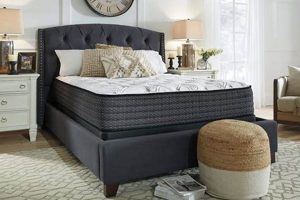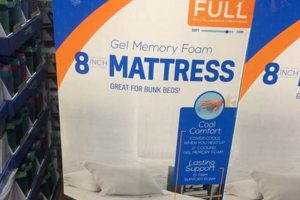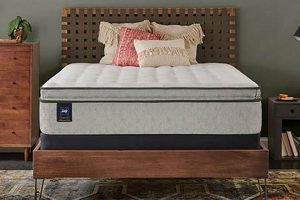A mattress designed to fit within the frame of a sofa bed, sized to accommodate two adults, is a common need for those seeking to enhance the comfort of their convertible furniture. These mattresses are specifically engineered to fold and unfold easily along with the sofa bed mechanism, while still providing adequate support for sleeping. For example, instead of enduring the discomfort of thin, worn springs, individuals can install a higher-quality foam or innerspring option to improve sleep quality.
The significance of upgrading this component lies in improved sleep ergonomics and extending the lifespan of the sofa bed. Over time, the original mattress may degrade, resulting in discomfort and reduced functionality. Replacing it offers several benefits, including enhanced support, pressure relief, and a more sanitary sleeping surface. Historically, sofa bed mattresses were often an afterthought in furniture design, but modern options focus on delivering a sleep experience comparable to a standard bed.
The following sections will delve into the various types of mattresses available, factors to consider when selecting a suitable option, installation guidelines, and maintenance tips to ensure longevity and sustained comfort.
Guidance on Sofa Bed Mattress Replacement
Proper selection and maintenance are critical for achieving optimal comfort and extending the lifespan of a new component. The following guidance assists in making informed decisions regarding the implementation.
Tip 1: Measure Accurately. Before purchasing, meticulously measure the interior dimensions of the sofa bed frame. Accurate measurements ensure a proper fit, preventing issues such as difficulty folding the sofa or insufficient support.
Tip 2: Consider Material Composition. Various materials offer different levels of support and comfort. Memory foam conforms to the body, while innerspring provides a firmer feel. Consider personal preferences and any specific needs, such as pressure point relief.
Tip 3: Evaluate Thickness. The thickness affects both comfort and the ability to fold the sofa bed. A thicker mattress may offer greater comfort but could hinder the folding mechanism. Balance comfort with practicality.
Tip 4: Check for Certifications. Look for certifications like CertiPUR-US, which indicates the foam has been tested for harmful substances and meets specific standards for content, emissions, and durability.
Tip 5: Investigate Warranty and Return Policies. Prior to purchase, carefully review the warranty and return policies. A warranty protects against manufacturing defects, and a flexible return policy allows for assessment of comfort and suitability within a specified timeframe.
Tip 6: Consider Weight Capacity. Verify the weight capacity to ensure it aligns with the intended users. Exceeding the weight limit can lead to premature wear and tear and compromise support.
Tip 7: Assess Breathability. Certain materials promote airflow, which can regulate temperature and prevent overheating during sleep. Consider options with breathable covers or open-cell foam structures.
Implementing these tips ensures a successful upgrade, leading to improved sleep quality and enhanced usability of the sofa bed. A well-chosen component represents a long-term investment in comfort and functionality.
The subsequent section explores common issues and troubleshooting strategies associated with these replacements.
1. Dimensions
The dimensions of a replacement sofa bed mattress are intrinsically linked to its suitability for a given sofa bed frame. Deviations from the standard full size specifications can lead to functional impairments and decreased comfort. Accurate dimensions, encompassing length, width, and thickness, ensure a snug fit within the frame, allowing for proper folding and unfolding of the sofa bed mechanism. For instance, a mattress that is slightly too wide may prevent the sofa from closing completely, while one that is too short may leave unsupported gaps. The intended “full” size dictates these measurements, generally around 54 inches in width and 75 inches in length, though variations exist.
The precise dimensions are also directly relevant to the comfort provided by the mattress. Inconsistent dimensions may result in uneven weight distribution, leading to pressure points and discomfort during sleep. A mattress that is too thin, even if correctly sized in width and length, may fail to offer adequate support, negating the purpose of the replacement. Therefore, understanding the interplay between specific dimensions and overall functionality is crucial for selecting an appropriate component.
In summary, adhering to the dimensional specifications of a “full” size replacement is paramount for ensuring both the functionality of the sofa bed and the comfort of the user. Ignoring these dimensions can result in a product that is unusable or provides a substandard sleep experience. The accurate assessment and matching of dimensions are therefore foundational to the successful replacement and subsequent utilization of the sofa bed.
2. Material Composition
The composition of materials in a replacement sofa bed mattress directly dictates its comfort, durability, and suitability for its intended function. The selection of specific materials impacts factors such as support, temperature regulation, and longevity, ultimately influencing the overall performance of the replacement component.
- Foam Density and Type
Foam density, measured in pounds per cubic foot, determines the level of support and resistance to compression. Higher density foams offer greater support and durability, resisting sagging and maintaining their shape over time. Memory foam, polyurethane foam, and latex foam are common choices, each with distinct properties. Memory foam conforms to the body, providing pressure relief, while latex offers a more resilient feel. The chosen foam type influences the overall comfort and suitability for individual sleep preferences in a “full” sized component.
- Innerspring Coil Design
Innerspring mattresses utilize coils to provide support. The coil design, including the gauge of the wire and the coil configuration, impacts the firmness and motion isolation. Individually wrapped coils minimize motion transfer, reducing disturbance from a sleeping partner. The number of coils also contributes to overall support. A higher coil count typically indicates a more supportive and durable “full” mattress, suitable for heavier individuals or those seeking enhanced spinal alignment.
- Cover Fabric and Construction
The cover fabric plays a significant role in breathability and temperature regulation. Materials like cotton, bamboo, or specialized performance fabrics can enhance airflow, preventing overheating and promoting a comfortable sleep environment. The construction of the cover, including quilting and stitching patterns, can also impact surface comfort and durability. A well-constructed cover protects the inner materials and extends the lifespan of the “full” sized mattress.
- Flame Retardant Materials
Regulations mandate the use of flame retardant materials in mattresses. These materials are designed to slow or prevent the spread of fire. While essential for safety, the choice of flame retardant can impact the overall chemical composition and potential off-gassing. Manufacturers often use materials like silica or inherently flame-resistant fibers as safer alternatives to chemical treatments. Understanding the type of flame retardant used is an important consideration for health-conscious consumers evaluating a “full” sized replacement.
The interplay of these material components directly influences the performance and lifespan of a “full” size replacement. Selecting materials that align with individual comfort preferences, support requirements, and safety considerations is crucial for ensuring a satisfactory and long-lasting upgrade to the sofa bed.
3. Thickness
Thickness is a critical parameter in the context of a replacement sofa bed mattress, influencing comfort, functionality, and the overall performance of the sofa bed mechanism. Selecting an appropriate thickness requires careful consideration of the sofa bed frame’s design limitations and the user’s comfort preferences.
- Comfort and Support
The thickness of a replacement directly correlates with the level of support and cushioning provided. A thicker mattress generally offers greater pressure relief and spinal alignment. However, excessively thick options may compromise the sofa bed’s folding mechanism. For instance, a thin foam mattress, approximately 4 inches thick, may provide insufficient support for heavier individuals, leading to discomfort and potential back pain. Conversely, a thicker mattress, exceeding 6 inches, may hinder the sofa’s ability to close completely, rendering the bed unusable as a sofa. The correlation must be well-balanced when selecting a “full” sized option.
- Folding Mechanism Compatibility
Sofa bed frames are designed with specific dimensional constraints to accommodate the mattress during folding and unfolding. The thickness of a replacement must align with these limitations to ensure smooth operation. A mattress that is too thick may exert undue stress on the folding mechanism, potentially causing damage or malfunction. Examples include scissor-style mechanisms that require a thinner profile and bifold designs that can accommodate slightly thicker options. Compatibility is a key factor of “full” sized models.
- Storage Space Constraints
Some sofa beds incorporate a storage compartment beneath the seating area. The thickness of the replacement influences the available storage space when the sofa is in bed configuration. A thicker mattress reduces the vertical clearance, potentially limiting the size and quantity of items that can be stored. Trade-offs between comfort and storage capacity must be considered when determining the optimal thickness for “full” replacement.
- Edge Support and Stability
The thickness of a replacement contributes to its edge support and overall stability. Thicker mattresses tend to exhibit better edge support, minimizing sagging and providing a more uniform sleeping surface. Adequate edge support is particularly important for individuals who sleep near the edge of the bed or require assistance getting in and out of bed. Consistent support across the entire surface enhances the sleep experience for “full” mattress users.
In conclusion, the selection of an appropriate thickness for a replacement necessitates a balanced approach that considers comfort requirements, folding mechanism compatibility, storage space constraints, and edge support considerations. Failing to address these factors can result in a compromised sleep experience and potential damage to the sofa bed itself. The selection is therefore, a critical stage of ensuring a successful replacement outcome for a “full” model.
4. Support and Firmness
The interplay between support and firmness is paramount when selecting a replacement for a sofa bed mattress. These qualities directly influence spinal alignment, pressure relief, and overall sleep quality. The appropriateness of a given support and firmness level is subjective, depending on individual body weight, sleeping position, and personal preferences. A mismatch between these factors can lead to discomfort, pain, and disrupted sleep.
- Spinal Alignment
Proper spinal alignment is crucial for preventing back pain and promoting restful sleep. The mattress should contour to the body’s natural curves, providing adequate support to the lumbar region, shoulders, and hips. A mattress that is too soft may allow the spine to sag, while one that is too firm may create pressure points. For example, side sleepers typically benefit from a softer mattress that allows the shoulders and hips to sink in, while back sleepers may prefer a firmer surface to maintain spinal alignment. In the context of a “full” size replacement, spinal alignment capabilities are pivotal in assessing its suitability.
- Pressure Relief
Pressure points occur when specific areas of the body bear the brunt of the weight, leading to discomfort and restricted blood flow. A mattress with good pressure relief properties distributes weight evenly, minimizing these hot spots. Materials such as memory foam and latex are known for their ability to conform to the body and alleviate pressure. Individuals with arthritis or other joint pain may find that a mattress with enhanced pressure relief significantly improves their sleep quality. As replacements for “full” mattresses, pressure relief features are important.
- Body Weight Distribution
The ability of a mattress to distribute body weight evenly is closely tied to both support and firmness. A mattress that effectively distributes weight prevents localized pressure and promotes overall comfort. Heavier individuals typically require a firmer mattress to prevent excessive sinking, while lighter individuals may find a softer mattress more comfortable. For a “full” sized replacement, the distribution capability defines its success in achieving optimum comfort.
- Sleeping Position Considerations
Sleeping position influences the optimal level of support and firmness. Side sleepers generally benefit from a softer mattress that conforms to the contours of the body, alleviating pressure on the shoulders and hips. Back sleepers may prefer a medium-firm mattress that provides support to the lumbar region. Stomach sleepers typically require a firmer mattress to prevent the spine from arching excessively. Selecting the right level of support and firmness based on sleeping position is crucial for preventing pain and promoting restful sleep when considering a “full” sized option.
The selection of a replacement should prioritize the alignment of support and firmness with individual needs and preferences. Evaluating these factors ensures that the replacement provides the necessary comfort and spinal alignment to promote restful and pain-free sleep. Such an exercise is critical in ensuring the replacement “full” mattress meets user requirements.
5. Foldability
Foldability, as it pertains to a replacement sofa bed mattress, is a core functional attribute directly impacting the sofa bed’s usability. The ability of the mattress to conform to the folding mechanism without compromising its structural integrity or comfort is paramount. The selection criteria must prioritize this attribute to ensure seamless transitions between sofa and bed configurations. A failure in foldability negates the primary purpose of the convertible furniture.
- Material Resilience and Hinge Points
The inherent resilience of the mattress materials and the strategic placement of hinge points are crucial to foldability. Materials with high elasticity, such as specific foam formulations or innerspring designs engineered for flexibility, facilitate compression and bending without permanent deformation. Hinge points, often achieved through segmented construction or strategically placed seams, define the areas where folding occurs. Improper hinge point design can lead to uneven folding, stress on the folding mechanism, and ultimately, damage to the mattress and sofa bed frame. A “replacement sofa bed mattress full” relies on these material properties to function effectively.
- Thickness and Compression Ratio
The thickness of a replacement mattress directly impacts its foldability, influencing the compression ratio required for successful folding. Thicker mattresses necessitate a higher compression ratio, potentially straining the folding mechanism and compromising comfort. Conversely, excessively thin mattresses may lack adequate support. The optimal thickness balances support requirements with the constraints imposed by the folding mechanism. A well-chosen “replacement sofa bed mattress full” navigates this balance seamlessly.
- Construction and Panel Design
The internal construction and panel design contribute significantly to the ability to fold correctly. Multi-panel designs, where the mattress is divided into distinct sections connected by flexible seams, enhance maneuverability and reduce stress on the folding mechanism. The type of stitching, seam placement, and panel size are critical variables. Faulty construction can result in bunching, tearing, and an inability to achieve a flat sleeping surface once unfolded. Successful designs for “replacement sofa bed mattress full” models will emphasize robust construction.
- Weight Distribution and Balance
Balanced weight distribution across the mattress is essential for proper folding. Uneven weight distribution can cause certain sections to resist folding, leading to uneven compression and potential damage to the folding mechanism. Internal support structures and material distribution must be carefully engineered to ensure a consistent folding action. The weight has to be well managed with the “replacement sofa bed mattress full”.
In summary, foldability hinges upon a complex interplay of material properties, construction techniques, and design considerations. A replacement must be engineered to withstand repeated folding and unfolding cycles without compromising its structural integrity or the functionality of the sofa bed mechanism. The considerations highlighted above are critical to ensuring its success, and the comfort of any “replacement sofa bed mattress full”.
Frequently Asked Questions
The following addresses common inquiries and concerns regarding the selection and use of a replacement for a sofa bed mattress.
Question 1: How does one determine the correct dimensions for a replacement model?
Precise measurement of the sofa bed frame’s interior is imperative. The length, width, and depth of the existing mattress cavity dictate the dimensions required for the replacement. Adherence to these measurements ensures proper fit and functionality of the folding mechanism.
Question 2: What material compositions are best suited for enhancing comfort and durability?
Memory foam, latex, and high-density polyurethane foam represent viable options. Memory foam offers superior pressure relief, while latex provides greater resilience and breathability. High-density polyurethane foam offers a balance of support and affordability. The selection depends on individual comfort preferences and budget constraints.
Question 3: Does the thickness of the new mattress affect the sofa bed’s folding mechanism?
Indeed, the thickness of the replacement is directly linked to the proper functioning of the folding mechanism. An excessively thick mattress may hinder the sofa’s ability to close completely, while an overly thin option may lack adequate support. A balanced approach, considering both comfort and mechanical compatibility, is essential.
Question 4: How does one assess the support and firmness levels appropriate for individual needs?
Body weight, sleeping position, and personal preferences dictate the ideal support and firmness characteristics. Side sleepers typically benefit from a softer mattress, while back and stomach sleepers may require a firmer surface. Individuals with higher body weights generally need more support to prevent excessive sinking.
Question 5: What are the primary factors contributing to the long-term durability of the mattress?
High-quality materials, robust construction techniques, and proper maintenance practices contribute to extended lifespan. Opting for mattresses with reinforced edges, durable covers, and warranties provides added assurance of longevity. Periodic rotation and protection from spills also enhance durability.
Question 6: What steps are involved in properly installing a replacement?
Installation typically involves removing the old mattress, unfolding the sofa bed frame, positioning the new mattress within the frame, and securing any fastening mechanisms. Ensuring proper alignment and secure attachment is crucial for preventing shifting and maintaining the integrity of the folding mechanism.
The preceding information aims to address key concerns and provide guidance for selecting and implementing a replacement.
The following section details potential issues and troubleshooting strategies.
Conclusion
The selection and implementation of a suitable replacement sofa bed mattress full requires careful consideration of dimensional accuracy, material composition, thickness, support characteristics, and foldability. The aforementioned factors directly influence comfort, functionality, and longevity of the sofa bed unit. Failing to adequately address these parameters can result in compromised sleep quality, reduced sofa bed lifespan, and potential damage to the folding mechanism.
Therefore, a thorough assessment of individual needs, combined with a comprehensive understanding of available options, is paramount. By prioritizing informed decision-making, individuals can optimize their investment and ensure a satisfactory and durable sleep solution. Further research into emerging materials and design innovations may yield enhanced performance and longevity in future iterations of the replacement sofa bed mattress full.




![Best Floor Mattress Full Size [2024]: Guide & Reviews Organic & Natural Mattress Buyer’s Guide: Non-Toxic Sleep Solutions Best Floor Mattress Full Size [2024]: Guide & Reviews | Organic & Natural Mattress Buyer’s Guide: Non-Toxic Sleep Solutions](https://mattressworldpa.com/wp-content/uploads/2025/07/th-2747-300x200.jpg)


![Best Full Tri Fold Mattress [Deals!] For Guests Organic & Natural Mattress Buyer’s Guide: Non-Toxic Sleep Solutions Best Full Tri Fold Mattress [Deals!] For Guests | Organic & Natural Mattress Buyer’s Guide: Non-Toxic Sleep Solutions](https://mattressworldpa.com/wp-content/uploads/2025/07/th-2744-300x200.jpg)